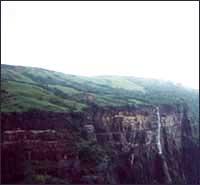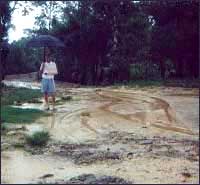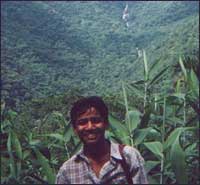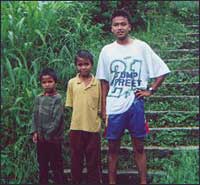|
Travelogues Cherrapunjee: Where Rain Is Measured In Feet
|
|||||
"I will run down the steps to the village and get some help. It will only take me a few minutes."
"Wait, Joel, let me just lie here for a while and recover a little."
"You slipped on some jackfruit skin, its extremely slippery." said Joel, pointing to the decaying fruit laying on the stone steps.
I looked at my left arm and noticed that the bone in my forearm was broken about 6" above the wrist. Luckily, the skin was intact and I didn't feel much pain. Using my umbrella as a walking stick, I followed Joel and slowly made my way to the village near the river.
|
More on North East • Meghalaya Travelogues • Footprints in Snow • Toy Train to Darjeeling Mountaineering • Across Himalayas
Trekking | ||||
Paradise washed
M  ost people's idea of Paradise is relaxing on a sunny tropical beach; mine is just the opposite. I recently went to one of the world's wettest places specifically to experience the heavy rains. The average yearly rainfall of 460" (1168 cms.) puts Mt. Waialeale on the island of Kauai in Hawaii at the top of the list of the world's wettest places. A close second, at 450" (1143 cms.) per year, is the town of Cherrapunjee, locally known as Cherra, in north-eastern India. The rainfall on Mt. Waialeale is spread over 12 months, while Cherra gets almost all of its' rain in the six monsoon months of April through September. And nobody lives on Mt. Waialeale, whereas 70,000 people call Cherra their home. For purists, I might mention that Mawsynram, just 10 miles west of Cherra, has recently earned the title as the world's wettest spot with an average annual rainfall of 467 inches. ost people's idea of Paradise is relaxing on a sunny tropical beach; mine is just the opposite. I recently went to one of the world's wettest places specifically to experience the heavy rains. The average yearly rainfall of 460" (1168 cms.) puts Mt. Waialeale on the island of Kauai in Hawaii at the top of the list of the world's wettest places. A close second, at 450" (1143 cms.) per year, is the town of Cherrapunjee, locally known as Cherra, in north-eastern India. The rainfall on Mt. Waialeale is spread over 12 months, while Cherra gets almost all of its' rain in the six monsoon months of April through September. And nobody lives on Mt. Waialeale, whereas 70,000 people call Cherra their home. For purists, I might mention that Mawsynram, just 10 miles west of Cherra, has recently earned the title as the world's wettest spot with an average annual rainfall of 467 inches.
The quest begins
So, why does Cherra get so much rain? The terrain rises steeply from the India-Bangladesh border to Cherra, which sits at an elevation of 4,500 ft. (1372m.). After passing over the Bangladesh Plains, the monsoon clouds hit Cherra with a vengeance. A world record 1,042 inches (2647 cm.) of rain fell between August 1860 and July 1861. More recently, the year 1974 saw 967 inches (of rain with an astounding 323 inches in just the month of July. That's 10 inches (25 cm.) a day for an entire month! There is only one kind of downpour; Noah's Ark comes to mind. On June 16, 1995, a record 62inches of rain fell in just 24 hours. It rained about an inch the first night, but as I walked the next morning, there was only heavy mist. The road ended in about a mile, and soon I reached one of the many villages tucked away in the hills and accessed only on foot by stone steps. Even though I could not speak Khasi, the local language, I had no trouble finding someone who could speak English. It is the only Indian state, albeit a small one, with a predominantly Christian population. Another interesting fact is that the Khasis are of Mongolian stock and have a matrilineal society. Among the Khasis, it is only the youngest daughter who is eligible to inherit the ancestral property. During an especially brutal conflict a few centuries ago, a large number of young Khasi men were killed. Many young Khasi women had no choice but to marry their servants and the elders decreed that henceforth the children would be named after the mother. A descent too far Eventually, a man showed up with some liquid concoction that he had just made using local plants. He applied it to my arm, pulled and tugged at it for a few minutes and stepped back. Amazingly, my bone appeared to be straight and my pain almost gone. I gave him 200 Rupees, about 4 dollars, and he seemed genuinely pleased. Joel and I then climbed the steps and walked back five miles to our hotel. The next day, an orthopedist in Shillong reset other smaller fractures near my wrist and put my arm in a cast. The total cost, including an overnight stay in the hospital, amounted to $35.
The ultimate irony of my trip was learning that Cherra, in winter, has a drinking water shortage. Besides government apathy, several factors combine to create this ludicrous situation. The population has surged from 5,000 a few decades ago to nearly 70,000; primarily due to jobs available at the town's cement factory. The springs on which the water supply scheme depends have a very poor discharge. The town sits atop a very porous limestone layer; there is hardly any flooding or standing water. After my return from Cherra, heavy monsoon floods in July caused many deaths in various parts of India, but no flooding was reported around Cherra. Photo Credit : Dinesh Desai
|
|||||
Editor: Romola Butalia (c) India Travelogue. All rights reserved. |
|||||

 I arrived in Cherra on the afternoon of June 20. June is the month with the most rain; about 108"(274 cm.) on the average. My plan was to walk five to six hours every day, hopefully in some heavy rain. The town of Cherra is green but not as lush as you might expect. Most trees have been cut and turned into firewood. However, my hotel was a few miles outside the town of Cherra and the surrounding area was quite lush.
I arrived in Cherra on the afternoon of June 20. June is the month with the most rain; about 108"(274 cm.) on the average. My plan was to walk five to six hours every day, hopefully in some heavy rain. The town of Cherra is green but not as lush as you might expect. Most trees have been cut and turned into firewood. However, my hotel was a few miles outside the town of Cherra and the surrounding area was quite lush.
 In the afternoon, Joel, the 15 year old son of the resort's owner and I headed for a river, five miles (8 km.) and 2,000ft. (610m) below the hotel. We had descended over 1,000 stone steps and were only minutes from the river, when I slipped and fractured my arm. As I lay in the verandah of a hut in the village near the river, semi-conscious and unable to focus my eyes, I wondered how I was going to get back to the hotel. Meanwhile, a couple of villagers had gone looking for their medicine man.
In the afternoon, Joel, the 15 year old son of the resort's owner and I headed for a river, five miles (8 km.) and 2,000ft. (610m) below the hotel. We had descended over 1,000 stone steps and were only minutes from the river, when I slipped and fractured my arm. As I lay in the verandah of a hut in the village near the river, semi-conscious and unable to focus my eyes, I wondered how I was going to get back to the hotel. Meanwhile, a couple of villagers had gone looking for their medicine man.
 I felt quite comfortable with the cast and decided not to hurry back home. But another disappointment was in store for me. The rain gods didn't cooperate. In the two days prior to my arrival, it rained 19". During my seven-day stay, it rained only 10" and all of it at night. I have no explanation, but apparently, Cherra gets a lot of its' rain at night. Exasperated by the lack of opportunity to experience the rain, I finally walked out at 3 A.M. one night with an umbrella in one hand and a small flashlight in my mouth. Luckily, the temperature was quite pleasant. The heavy raindrops hitting the pavement soaked me upto my knees in a matter of minutes, but I was elated at finally getting my walk in the rain.
I felt quite comfortable with the cast and decided not to hurry back home. But another disappointment was in store for me. The rain gods didn't cooperate. In the two days prior to my arrival, it rained 19". During my seven-day stay, it rained only 10" and all of it at night. I have no explanation, but apparently, Cherra gets a lot of its' rain at night. Exasperated by the lack of opportunity to experience the rain, I finally walked out at 3 A.M. one night with an umbrella in one hand and a small flashlight in my mouth. Luckily, the temperature was quite pleasant. The heavy raindrops hitting the pavement soaked me upto my knees in a matter of minutes, but I was elated at finally getting my walk in the rain.